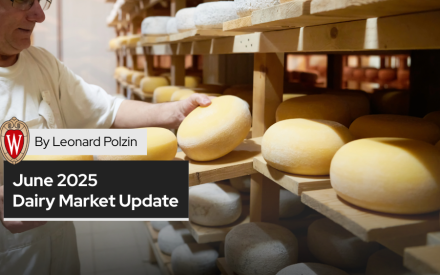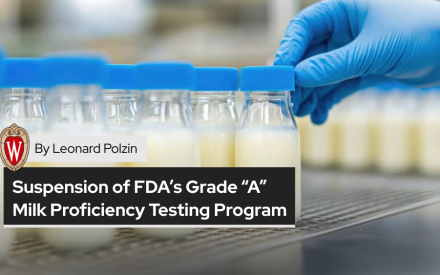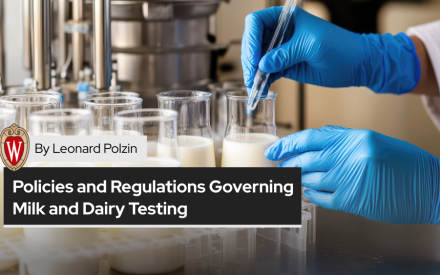
Introduction
Meals on Wheels (MOW) programs — primarily funded under the Older Americans Act (OAA) Nutrition Program — provide millions of meals to seniors across the United States each year. These meals are required to meet one-third of daily nutritional needs, including a dairy component with each meal [4]. As a result, MOW programs purchase substantial quantities of milk, cheese, yogurt, and other dairy products to meet nutritional standards. This report examines the quantity of dairy foods used and dollars spent by Meals on Wheels programs nationally and in Wisconsin, highlighting recent (past 1–2 years) versus historical trends. In addition, it reviews academic literature on the economic impact of Meals on Wheels, with emphasis on how the program influences dairy market clearing and market dynamics.
Dairy Procurement in Meals on Wheels Programs
Nationwide Dairy Usage and Expenditures
By mandate, each MOW meal includes one serving of milk or a dairy alternate (equivalent to 1 cup of milk) in order to provide sufficient calcium and protein [4]. Acceptable dairy components include a cup of milk (fat-free or low-fat), an 8-ounce serving of yogurt, or 1.5 ounces of natural cheese, among others [4]. Given this standard, the aggregate dairy usage by Meals on Wheels is considerable. Table 1 summarizes estimated annual dairy quantities and spending for MOW meals in the U.S., using 2019 (pre-pandemic) as a baseline and 2020 as a recent year of peak demand:
Table 1. Estimated Annual Dairy Products Usage by Meals on Wheels Programs (U.S.)
| Year | Total Meals Served (millions) [4][9] | Milk (8 oz servings, millions) | Cheese (1.5 oz servings, millions) | Yogurt (8 oz servings, millions) | Approximate Dairy Expenditures (USD) |
|---|---|---|---|---|---|
| 2019 | 223.0 | ~156.0 (≈7.6 million gallons) | ~44.6 (≈4.2 million pounds) | ~22.3 (≈1.1 million pounds) | ~$55–$65 million |
| 2020 | 247.4 (higher demand) | ~175.0 (≈8.7 million gallons) | ~50.0 (≈4.7 million pounds) | ~22.4 (≈1.1 million pounds) | ~$60–$70 million |
As shown in Table 1, MOW programs nationally served approximately 223 million meals in 2019, each including a dairy item. This implies on the order of ~156 million milk servings (about 7.6 million gallons) and tens of millions of servings of cheese or yogurt as alternates. The total spending on dairy products for Meals on Wheels in 2019 is estimated around $55–65 million (on the order of tens of millions of dollars). This was calculated using average per-meal ingredient cost data: nationally, raw food ingredients cost about $1.14–$1.28 per meal on average[1], of which dairy components (e.g. a carton of milk) account for roughly 20% (approximately $0.25). These figures rose in 2020, when pandemic disruptions led to a surge in home-delivered meals. In 2020 the program delivered an estimated 247 million meals, about 11% more than 2019, to meet increased need [9]. Accordingly, dairy usage also increased (Table 1). Even as congregate meal sites closed in 2020, home delivery expanded – 198.6 million home-delivered meals were provided in 2020, nearly 50 million more than in 2019 [9]—ensuring that dairy products still reached seniors.
Recent trends (2021–2023) indicate that Meals on Wheels’ dairy purchases remain elevated compared to pre-2020 levels. Many local programs are still serving more meals than before the pandemic[5]. At the same time, food price inflation has affected costs. In 2022, U.S. consumer prices for dairy products jumped about 15% year-over-year[6], straining MOW budgets. For example, one large Meals on Wheels program reported spending $3 million annually on food and packaging and noted that a 10% rise in food costs adds ~$400,000 to their expenses [5]. Thus, although the quantity of dairy procured remains high, the expenditure on dairy has grown faster recently due to higher prices. Many programs have had to budget more for milk and cheese to continue providing the required serving, illustrating how market price dynamics directly impact program costs.
Wisconsin-Specific Data on Dairy Usage
Wisconsin’s Meals on Wheels programs mirror national patterns. Wisconsin consistently ranks among the top states for senior nutrition program output. In the calendar year 2023, Wisconsin’s OAA Elder Nutrition Program (which includes Meals on Wheels) served a total of 3,855,221 meals to older adults [10]. This total comprised approximately 2.80 million home-delivered meals (MOW to homebound seniors), 0.84 million congregate meals at senior dining sites, and an additional 0.22 million carryout meals (a hybrid model post-COVID) [10]. Wisconsin’s program provided on the order of 3.85 million dairy servings in 2023.
To put the quantity in perspective, if all Wisconsin meals in 2023 had been accompanied by fluid milk, the volume would equate to roughly 241,000 gallons of milk used in one year (3.85 million cups ÷ 16 cups/gallon). Of course, some meals use cheese or yogurt alternatives, so actual milk volume is a bit lower, with cheese/yogurt making up the difference. Still, milk is the predominant dairy item served in Wisconsin’s Meals on Wheels due to its convenience and nutritional profile.
Historical Trend: Wisconsin’s senior meal service has grown over the past decade, driving dairy usage upward. In 2013, the state served about 3.6 million total meals, and by 2019 roughly 3.7 million meals were served (before the pandemic) [10]. The COVID-19 period saw a sharp increase: meals peaked at ~4.0 million in 2020 when additional federal emergency funds allowed programs to reach more seniors. Since then, annual meal counts have slightly stabilized; 2023’s total (3.85 million) is slightly below the 2020 high, but still above pre-2020 levels [10]. This trajectory means dairy purchases in Wisconsin have generally trended upward over time, with a notable spike in 2020. Correspondingly, expenditures on dairy in Wisconsin MOW programs likely rose from under $1 million annually pre-2020 to around $1.0–1.2 million in 2023 (assuming ~$0.25–0.30 per meal spent on dairy). These estimates align with the national cost patterns scaled to Wisconsin’s meal count. Wisconsin’s identity as “America’s Dairyland” may also influence menu choices – senior meal programs there can take advantage of local dairy suppliers, potentially at favorable cost, to include milk, cheese, or cottage cheese frequently. Overall, Wisconsin’s data shows the broader trend: Meals on Wheels represents a steady outlet for dairy products, with volumes increasing alongside program expansion.
Breakdown by Dairy Category
Across Meals on Wheels programs, the specific dairy products utilized can be broken down into several categories:
- Milk: Fluid cow’s milk (typically 1% or skim in 8 oz servings) is the most commonly served dairy item. It is often delivered as individual cartons or poured from bulk jugs at congregate sites. Given the meal counts, milk constitutes the largest share of MOW dairy volume. For instance, an estimated ~70% of national MOW meals use milk as the dairy component (Table 1), amounting to over 7 million gallons of milk annually in the U.S. before the pandemic, and near 8–9 million gallons at the height of 2020 demand (nationally). Milk provides key nutrients (calcium, vitamin D, protein) to seniors and is cost-effective, which explains its prominence.
- Cheese: Many Meals on Wheels menus incorporate cheese either as a standalone alternative to milk or as an ingredient in entrees (e.g. casseroles, lasagna, sandwiches). Per OAA guidelines, 1.5 ounces of natural cheese (or 2 oz processed cheese) counts as one milk equivalent [4]. Nationally, we estimate cheese accounts for ~20% of dairy servings in MOW. In 2019, this would translate to on the order of 4–5 million pounds of cheese used by Meals on Wheels programs (see Table 1). Common types include cheddar or American cheese (sometimes received via USDA commodity programs) and cottage cheese. Cheese is slightly more costly per serving than milk, but it is often used to add variety or accommodate those who do not drink milk. Some programs also provide items like cheese sticks or slices as part of cold meal packs.
- Yogurt: Although less ubiquitous, yogurt (usually plain or low-sugar, 6–8 oz cups) is sometimes offered as the dairy serving. It may be favored for clients who are lactose-intolerant (lactose-free milk is another option — or as a menu change of pace. Yogurt likely comprises a small portion of meals (perhaps ~10% or less). Based on national meal numbers, one can infer on the order of 1–2 million pounds of yogurt were used annually in recent years by MOW programs. Greek yogurt can also boost protein content of meals. However, cost and storage issues (keeping yogurt chilled) mean it is not as widespread as milk or cheese.
- Other Dairy: This includes items such as butter, margarine, or cream used in meal preparation. While not served as the “milk equivalent” component, many MOW programs use butter or dairy-based sauces in recipes. These would fall under general food ingredients rather than counted dairy servings. Their usage is harder to quantify but is relatively minor compared to milk/cheese. Another “other dairy” category is fortified soy milk, which some programs use as a milk substitute for vegan or allergic clients [4] — this is not a dairy product per se, but it fulfills the dairy requirement nutritionally. In Wisconsin, presumably due to its dairy farming history, actual non-dairy substitutes seem to be used less; elsewhere, some programs do procure soy milk or lactose-free milk for those who need it. Overall, butter and cream purchases are a small fraction of total dairy expenditure in Meals on Wheels (mostly used for cooking). The bulk of spending is on fluid milk, cheese, and yogurt.
In summary, milk and cheese dominate the dairy profile of Meals on Wheels. These categories are vital to meeting nutrition standards and are purchased in large quantities by programs nationwide. Yogurt and other dairy products play a smaller role. The precise mix varies by locality — some programs serve milk with every meal, others might alternate milk and cheese on different days — but the presence of some form of dairy in each meal is a constant, generating a steady demand for dairy products.
Economic Impact on Dairy Markets and Market Dynamics
Meals on Wheels’ procurement of dairy products has implications for the dairy market, especially in terms of demand stabilization and market clearing. While MOW is a social service program, it effectively functions as an institutional buyer of dairy foods. Here we assess how the program impacts the dairy economy:
Interaction with Dairy Policy: Meals on Wheels operates at the intersection of nutrition policy and agricultural policy. While its primary goal is senior nutrition, it indirectly serves as a demand-side subsidy to the dairy industry. Federal funds (OAA Title III and NSIP grants) pay for a portion of the milk and cheese bought by programs[4]. In essence, taxpayer dollars help purchase dairy products for seniors, which also supports farmers by adding demand. This is analogous to other food assistance programs (e.g., the National School Lunch Program or WIC) that bolster demand for specific foods. The Nutrition Services Incentive Program (NSIP) in particular allows Meals on Wheels providers to receive USDA Foods (commodities) in lieu of cash; many programs have historically received USDA commodity cheese or milk powder to use in meals[1]. This direct commodity provision is a classic market-clearing mechanism: USDA buys surpluses on the market and channels them to MOW programs. When dairy markets are tight, conversely, MOW must pay prevailing market prices — which as noted can strain budgets when prices spike. In recent inflationary conditions, some programs had to reduce portions or find additional funding because the cost of dairy rose faster than their funding. Economically, this illustrates that MOW is a price-taker in the dairy market; it does not set prices but must respond to them. Its demand is relatively price-inelastic (they try to serve milk regardless of price), so MOW will cut other costs or seek subsidies rather than forego serving dairy. This inelastic demand means MOW purchases help maintain consumption of dairy even when prices rise, arguably supporting market prices by not dropping demand.
Contribution to Demand: The Meals on Wheels program increases overall demand for dairy by reaching a segment of the population (homebound, often low-income seniors) who might otherwise consume less dairy. Research shows that participation in home-delivered meal programs significantly increases seniors’ nutrient intake [2][5]. This includes higher consumption of protein, calcium and other nutrients abundant in milk and cheese. In economic terms, MOW shifts the demand curve for dairy outward modestly by providing dairy to tens of thousands of seniors daily who might not purchase it on their own due to cost or access barriers. Each year, MOW programs direct roughly 0.1- 0.2% of U.S. fluid milk production into senior meals (on the order of 8 million gallons out of ~5.5 billion gallons U.S. milk market), and a similar small fraction of cheese production. Although this share is small at the national scale, it is not negligible for clearing the market at the margin — particularly during times of surplus.
Market Clearing of Surplus: Government-supported feeding programs like Meals on Wheels have historically played a role in absorbing surplus agricultural products. In the dairy sector, this dates back to policies of the 1980s when the Commodity Credit Corporation would purchase excess milk and store it as cheese and butter [3]. Those surplus stocks were eventually distributed to nutrition programs for the needy, including senior meal programs. By redirecting surplus dairy to Meals on Wheels and similar programs, the government helps clear excess supply that might otherwise depress farm prices or go to waste. For example, during the 2020 pandemic, the USDA undertook large surplus food purchases (nearly $470 million of excess meat, dairy, and produce) to support food assistance efforts [11]. Meals on Wheels programs, which were scaling up meals by ~22% in 2020 [9], benefited from these initiatives, receiving dairy products (milk, cheese) to include in delivered meals. In economic terms, MOW adds a floor to dairy demand, albeit small: even when commercial demand falls (e.g., restaurant closures in COVID-19), Meals on Wheels will take up dairy for its clients, aided by emergency funding. This buffers the dairy market against shocks, albeit modestly.
Price and Market Dynamics: Because Meals on Wheels demand for dairy is relatively steady and inelastic (the program serves nutritionally required portions regardless of price fluctuations, within budget constraints), it can have a modest stabilizing effect on local dairy markets. MOW programs typically negotiate supply contracts or buy in bulk from local dairies or suppliers, providing a reliable customer for dairy processors. From the perspective of a regional dairy supplier, a county’s senior meal program guarantees a baseline volume (e.g. thousands of milk cartons per week), which can smooth demand variability. However, at the national level, the influence of MOW on dairy prices is limited by scale. Current dairy demand from MOW is too small to markedly move wholesale prices, according to economic analyses. A USDA analysis of dairy policies noted that overall effects of such programs on the market are “modest”[8]. In line with that finding, the incremental demand from Meals on Wheels likely has a modest upward influence on dairy prices – theoretically preventing prices from falling as low as they might in the absence of those purchases – but it does not significantly raise prices either. In Wisconsin, for instance, the ~240,000 gallons of milk used by MOW in 2023 is a drop in the bucket relative to Wisconsin’s annual milk output (about 3 billion gallons); yet for the small dairy vendors that win the supply contract for that milk (often local dairies), the program represents stable business.
Peer-Reviewed Evidence on Economic Impact
There is a growing academic literature evaluating Meals on Wheels’ impacts, though much of it focuses on health and cost-savings in healthcare rather than agricultural markets. Still, a few relevant insights emerge:
- Cost-Benefit and Spillovers: Thomas and Mor (2013) found that expanding Meals on Wheels yields net savings in Medicaid long-term care costs by keeping seniors out of nursing homes [2],[5]. While this is a healthcare outcome, it underscores the economic efficiency of the program. Healthier, independent seniors likely continue consuming foods (including dairy) in the community, which is a subtle long-run effect on food demand – they rely less on institutional food service and continue to be part of the consumer market.
- Food Security and Nutrition: Studies compiled by Gualtieri et al. (2018) conclude that home-delivered meal services significantly improve food security and diet quality for participants [2],[5]. This implies that Meals on Wheels increases the consumption of nutritious foods that participants might otherwise skip – dairy being a prime example (milk is often cited as too expensive for some seniors on fixed incomes). By improving access to dairy, MOW enhances the utilization of dairy market output in a population that might be under-consuming. In economic terms, it converts what might be “latent demand” (desire but no purchasing power) into actualized demand via subsidy.
- Dairy Market Equilibrium: While no known study isolates Meals on Wheels’ effect on dairy prices, one can extrapolate from economic theory and analogous programs. The presence of a guaranteed buyer (backed by federal funds) for a portion of dairy supply tends to reduce volatility. If MOW were to shrink or be defunded, those millions of servings of dairy would need to find alternate buyers or the milk would end up as surplus. Conversely, if MOW expanded significantly (for instance, reaching all seniors in need), it would modestly raise overall dairy demand. Given the elasticity of demand for dairy is not very high in the short run, a demand increase from MOW could firm up prices slightly. However, the ERS economic analysis of dairy policies concludes that current programs (including food assistance demand) have only modest market effects [8]. Technology, international trade, and major commercial buyers have far larger impacts on dairy market dynamics than Meals on Wheels. Thus, we can infer that the economic impact of Meals on Wheels on dairy market clearing is real but limited — it helps clear the market of some excess and adds a steady trickle of demand, contributing to equilibrium, but it is not a primary driver of dairy prices or production decisions.
- Local Economic Benefits: On a regional level, Meals on Wheels can have more palpable impacts. In dairy-producing states like Wisconsin, Michigan, or California, local Meals on Wheels programs often source from nearby dairies, injecting money into the local agricultural economy. The program’s expenditures on dairy (e.g., Wisconsin’s ~$1 million/year) support jobs in dairy processing and distribution. Additionally, some programs have formed partnerships with dairy co-ops or creameries for donations or discounts, especially during oversupply periods. For instance, if dairy farmers face a glut of milk, they may donate milk to MOW programs (with processing help) rather than dump it, which again aids in market clearing and provides economic value (tax deductions for donors, lower food costs for programs). These micro-level dynamics illustrate the role of MOW as a market intermediary that can channel dairy products to where they are needed, with economic gains for both producers and consumers (seniors).
Conclusion
Meals on Wheels programs across the United States are institutional consumers of dairy products, purchasing large quantities of milk, cheese, yogurt and related items to meet nutritional requirements. Nationally, on the order of 220–250 million meals are served annually in recent years [4],[9], translating to hundreds of millions of dairy servings each year. This includes roughly 7–9 million gallons of milk and several million pounds of cheese and yogurt provided to older Americans through the program. In Wisconsin alone, nearly 4 million meals (2023) equated to about 3.85 million dairy servings for seniors [10]. Both the quantities and expenditures on dairy have trended upward over time, with a notable surge during the COVID-19 pandemic due to increased meal delivery and higher food prices.
From an economic standpoint, Meals on Wheels provides a steady demand base for dairy products, contributing to market clearing by absorbing some surplus and helping stabilize demand. The program’s effect on dairy market dynamics is positive but modest — it ensures a reliable outlet for a portion of dairy production and thereby marginally supports farm prices and possibly reduces waste in times of oversupply. Peer-reviewed studies affirm that the program increases participants’ intake of nutritious foods [2],[5] (thereby effectively expanding dairy consumption) and can yield broader economic benefits such as healthcare savings [2],[5]. While the long-term viability of the dairy industry does not hinge on Meals on Wheels, the program is part of food institutions that collectively bolster the dairy market. Meals on Wheels is a win-win in the sense that: it improves senior nutrition by delivering milk, cheese, and other dairy products to those in need, while simultaneously providing a stable, socially-driven source of demand for the dairy sector. This relationship shows the often under-appreciated economic impact of nutrition programs on agricultural markets. By continuing to invest in Meals on Wheels, society supports not vulnerable seniors and the functioning of dairy markets through a dependable clearing of a portion of dairy output in a way that yields social returns [8].
Overall, the data and literature suggest that Meals on Wheels is a cost-effective program that, among its many benefits, meaningfully contributes to dairy consumption and market stability. Future research could further quantify the exact effects and explore how expanding senior nutrition programs might influence dairy demand in an aging America. Evidence indicates that Meals on Wheels plays a modest yet important role in ensuring that milk and dairy products find their way to those who need them, thereby enhancing both nutrition security and economic efficiency in the dairy marketplace.
References
- Administration for Community Living. (2022). Older Americans Act nutrition programs fact sheet. U.S. Department of Health and Human Services. https://acl.gov/programs/health-wellness/nutrition-services
- Gualtieri, M. C., Donley, L., Gordon, S., & Trivedi, A. (2018). Addressing nutrition insecurity in vulnerable older adults: Home-delivered meal services. Journal of Nutrition in Gerontology and Geriatrics, 37(3–4), 121–130. https://doi.org/10.1080/21551197.2018.1560540
- History.com Editors. (2018). How the U.S. ended up with warehouses full of ‘government cheese’. History.com. https://www.history.com/news/government-cheese-surplus-dairy
- Meals on Wheels America. (2022). Wisconsin fact sheet. https://www.mealsonwheelsamerica.org/docs/default-source/fact-sheets/2022/factsheet-wi.pdf
- Imperfect Foods. (2020, May 13). USDA to purchase $470M in surplus food to support farmers and food banks. https://www.imperfectfoods.com/blog/usda-surplus-food-purchase
- Sadarangani, T. R., Johnson, S. C., & Sharif, S. (2021). Enriching nutrition programs to better serve the needs of a diversifying aging population. Family & Community Health, 44(2), 127–136. https://doi.org/10.1097/FCH.0000000000000288
- U.S. Bureau of Labor Statistics. (2023). Consumer price index – Dairy products, 2022 annual averages. https://www.bls.gov/cpi/
- U.S. Department of Agriculture. (2017). Nutrition standards for the Older Americans Act nutrition programs. Food and Nutrition Service. https://www.fns.usda.gov/oaa/nutrition-standards
- U.S. Department of Agriculture Economic Research Service. (2010). Economic effects of U.S. dairy policy. https://www.ers.usda.gov/publications/pub-details/?pubid=44778
- U.S. Senate Special Committee on Aging. (2020). Meals on Wheels and COVID-19: Sustaining services for seniors. https://www.aging.senate.gov/imo/media/doc/COVID19%20Meals%20on%20Wheels%20Report.pdf
- Wisconsin Department of Health Services. (2024). Elder nutrition program: Annual report, 2023. https://www.dhs.wisconsin.gov/aging/nutrition.htm
- Woodruff, B. (2022, May 17). Meals on Wheels struggles to keep up with inflation, demand amid food insecurity rise. ABC News.https://abcnews.go.com/Health/meals-wheels-struggles-keep-inflation-demand-amid-food/story?id=84750429


 Dairy Market Dynamics and Domestic Constraints: A Dairy Sector Assessment as of June 2025
Dairy Market Dynamics and Domestic Constraints: A Dairy Sector Assessment as of June 2025 U.S.–Canada Dairy Trade Relationship (2025–Present)
U.S.–Canada Dairy Trade Relationship (2025–Present) Suspension of FDA’s Grade “A” Milk Proficiency Testing Program – A Comprehensive Analysis
Suspension of FDA’s Grade “A” Milk Proficiency Testing Program – A Comprehensive Analysis Policies and Regulations Governing Milk and Dairy Testing: A Wisconsin Overview
Policies and Regulations Governing Milk and Dairy Testing: A Wisconsin Overview


